Port Of Long Beach
Topic 32886 | Page 1
I work for a company that does nothing but strictly fresh meat loads that goes to the Port of Oakland every week. Our runs are different than what you described you would be doing. We pick up in Marshalltown IA, several places in Nebraska...I just parked for the night in Lexington NE where I will hook to my load tomorrow and start heading to the Port of Oakland. We also pick up in Greeley and Fort Morgan CO, Dodge City and Liberal KS and Guymon OK. We pick up usually on Friday or Saturday and deliver Monday or Tuesday weather permitting. Coming out of the port, we have two places where we get our new chassis and empty container, then get a load out of somewhere in CA or NV and pretty much all of them go to Cheyenne or the Denver area. From there we deadhead to wherever our load planner has us set to get another meat load.
First you will need to get a TWIC card, and the company should pay for it, most do. You could make the runs, and the company will have somebody shuttle it in or have you drop it off at a yard down in that area that they do business with. I've never been to Long Beach and our company does go there once in a great while.
I find doiing containers is a dirtier job than driving reefers or dry vans, but at almost 72, it's still an easy enough job. The company gave me a cheater bar to get the corroded doors open and because I'm only 5'4" and the door latches are above my head. If I can't get a door open, I can usually find a guy who has just enough leverage to get them open.
As for pay, as long as you are a company driver, you could make that kind of money your first year if you hustle, I suppose. I'm getting 53 CPM and run between 11,000 and 13,500 by per month. I stay out four weeks then go home to south central ID for a week. I just started doing this job in June after being fired in May from my last company because I covered my driver facing camera. So this past year, with being off 5 weeks, I still grossed $60,000.
If I think of anything else I'll post when I get up. It's been a long day and I need to hit the bunk.
Laura
Deadhead:
To drive with an empty trailer. After delivering your load you will deadhead to a shipper to pick up your next load.
Dry Van:
A trailer or truck that that requires no special attention, such as refrigeration, that hauls regular palletted, boxed, or floor-loaded freight. The most common type of trailer in trucking.CPM:
Cents Per Mile
Drivers are often paid by the mile and it's given in cents per mile, or cpm.
Reefer:
A refrigerated trailer.
TWIC:
Transportation Worker Identification Credential
Truck drivers who regularly pick up from or deliver to the shipping ports will often be required to carry a TWIC card.
Your TWIC is a tamper-resistant biometric card which acts as both your identification in secure areas, as well as an indicator of you having passed the necessary security clearance. TWIC cards are valid for five years. The issuance of TWIC cards is overseen by the Transportation Security Administration and the Department of Homeland Security.
Our ports division has a lot of good opportunities. There's a lot of perks at Knight that are not always discussed by recruiting sometimes, so it's worth your time to check their website and see what kind of opportunities are there and follow up with the recruiter.
Like any company though, your outcome depends on you. There's good and bad with ports. The wait times and finding frames are the biggest complaints I've heard from the guys that do it.
Some folks here have had a tough time with Knight, others have had great experiences. Weather your ports or a different division, your top gun (if you get selected for it) and your training is done OTR dry van , although they may have changed that in that you may be training with port guys if your doing ports, I'd ask your recruiter about it.
Every once in a while I'll end up doing a port run with dry van. I have to use escorts because I don't have a twic card. Interesting enough place, but totally different end of it than containers. I've also pulled empties from ports only to have to go put them back, but that's just the life of dry van lol.
OTR:
Over The Road
OTR driving normally means you'll be hauling freight to various customers throughout your company's hauling region. It often entails being gone from home for two to three weeks at a time.
Dry Van:
A trailer or truck that that requires no special attention, such as refrigeration, that hauls regular palletted, boxed, or floor-loaded freight. The most common type of trailer in trucking.TWIC:
Transportation Worker Identification Credential
Truck drivers who regularly pick up from or deliver to the shipping ports will often be required to carry a TWIC card.
Your TWIC is a tamper-resistant biometric card which acts as both your identification in secure areas, as well as an indicator of you having passed the necessary security clearance. TWIC cards are valid for five years. The issuance of TWIC cards is overseen by the Transportation Security Administration and the Department of Homeland Security.
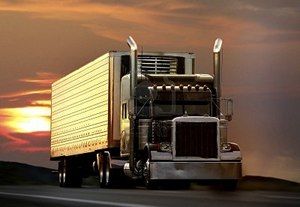
Thanks for the replies. So are you basically pulling a flatbed trailer which then has a shipping container placed on it? How is that secured?
Also, when I talk to the recruiter about that credential I need, do I say "twick card" or "tee double u eye see card"? I don't want to sound like an idiot to him/her. :)
TWIC:
Transportation Worker Identification Credential
Truck drivers who regularly pick up from or deliver to the shipping ports will often be required to carry a TWIC card.
Your TWIC is a tamper-resistant biometric card which acts as both your identification in secure areas, as well as an indicator of you having passed the necessary security clearance. TWIC cards are valid for five years. The issuance of TWIC cards is overseen by the Transportation Security Administration and the Department of Homeland Security.
It's pronounced tee wick. The frames for containers aren't a bed they sit on more like a framework with tandems. I'm sure there's probably one of the more experienced folks in here that have pulled containers thst could hopefully give more info than me.
Tandems:
Tandem Axles
A set of axles spaced close together, legally defined as more than 40 and less than 96 inches apart by the USDOT. Drivers tend to refer to the tandem axles on their trailer as just "tandems". You might hear a driver say, "I'm 400 pounds overweight on my tandems", referring to his trailer tandems, not his tractor tandems. Tractor tandems are generally just referred to as "drives" which is short for "drive axles".
Tandem:
Tandem Axles
A set of axles spaced close together, legally defined as more than 40 and less than 96 inches apart by the USDOT. Drivers tend to refer to the tandem axles on their trailer as just "tandems". You might hear a driver say, "I'm 400 pounds overweight on my tandems", referring to his trailer tandems, not his tractor tandems. Tractor tandems are generally just referred to as "drives" which is short for "drive axles".
It's pronounced tee wick. The frames for containers aren't a bed they sit on more like a framework with tandems. I'm sure there's probably one of the more experienced folks in here that have pulled containers thst could hopefully give more info than me.
You're correct. Just think of it as two bare frame rails and some crossmembers. There is a pin that sticks up at the four corners and the shipping container (conex) sits on these pins and is locked in place for transit.
Tandems:
Tandem Axles
A set of axles spaced close together, legally defined as more than 40 and less than 96 inches apart by the USDOT. Drivers tend to refer to the tandem axles on their trailer as just "tandems". You might hear a driver say, "I'm 400 pounds overweight on my tandems", referring to his trailer tandems, not his tractor tandems. Tractor tandems are generally just referred to as "drives" which is short for "drive axles".
Tandem:
Tandem Axles
A set of axles spaced close together, legally defined as more than 40 and less than 96 inches apart by the USDOT. Drivers tend to refer to the tandem axles on their trailer as just "tandems". You might hear a driver say, "I'm 400 pounds overweight on my tandems", referring to his trailer tandems, not his tractor tandems. Tractor tandems are generally just referred to as "drives" which is short for "drive axles".
It's pronounced like "wick" but with a "T" in front of it.
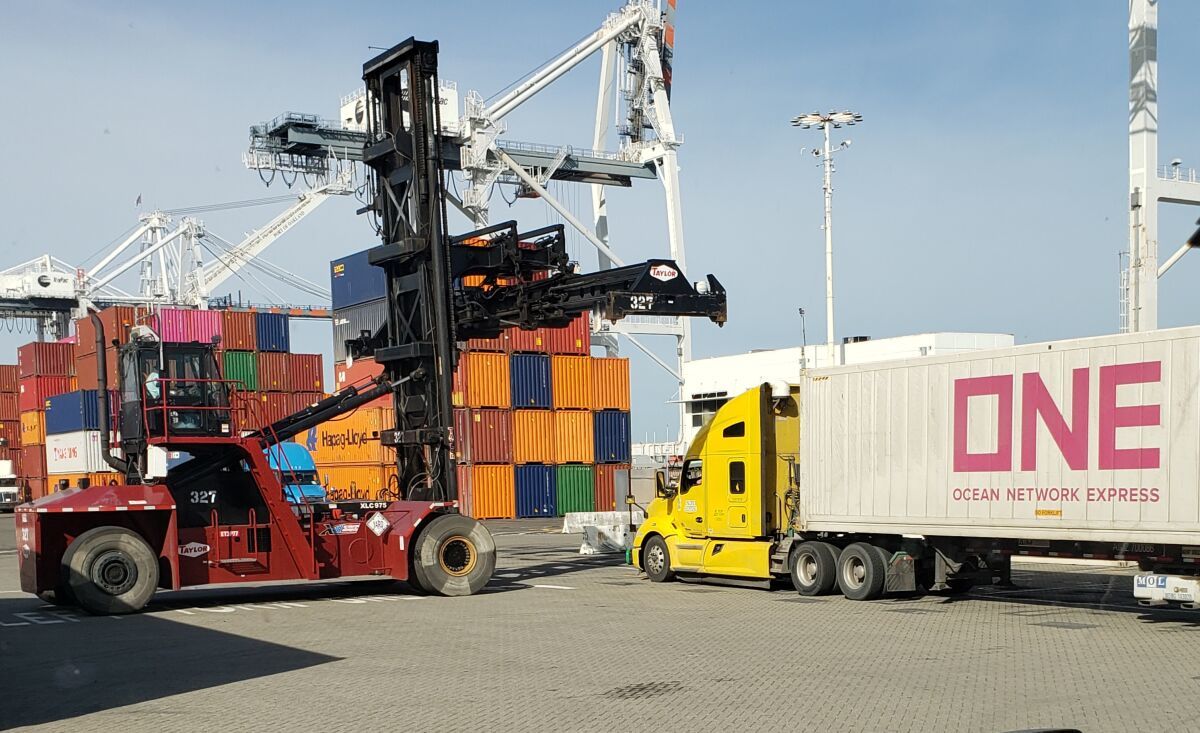


That is a reefer can.. if you look under the chassis in front of the trailers, you will see the GenSet with the fuel tank that is used over the road. When it is taken off the chassis and put on the ground at the port and on the ship, then it is plugged in just like your refrigerator at home is.
Got to go get my load and start heading to Oakland. If you have specific questions, you can ask here and I'll answer him later or you can text me.. my number is in my bio
Laura
Over The Road:
Over The Road
OTR driving normally means you'll be hauling freight to various customers throughout your company's hauling region. It often entails being gone from home for two to three weeks at a time.
Reefer:
A refrigerated trailer.

Wow those are some cool pictures! Thanks Laura. Travel safe.
HOS:
Hours Of Service
HOS refers to the logbook hours of service regulations.Maybe you can see the chassis better.
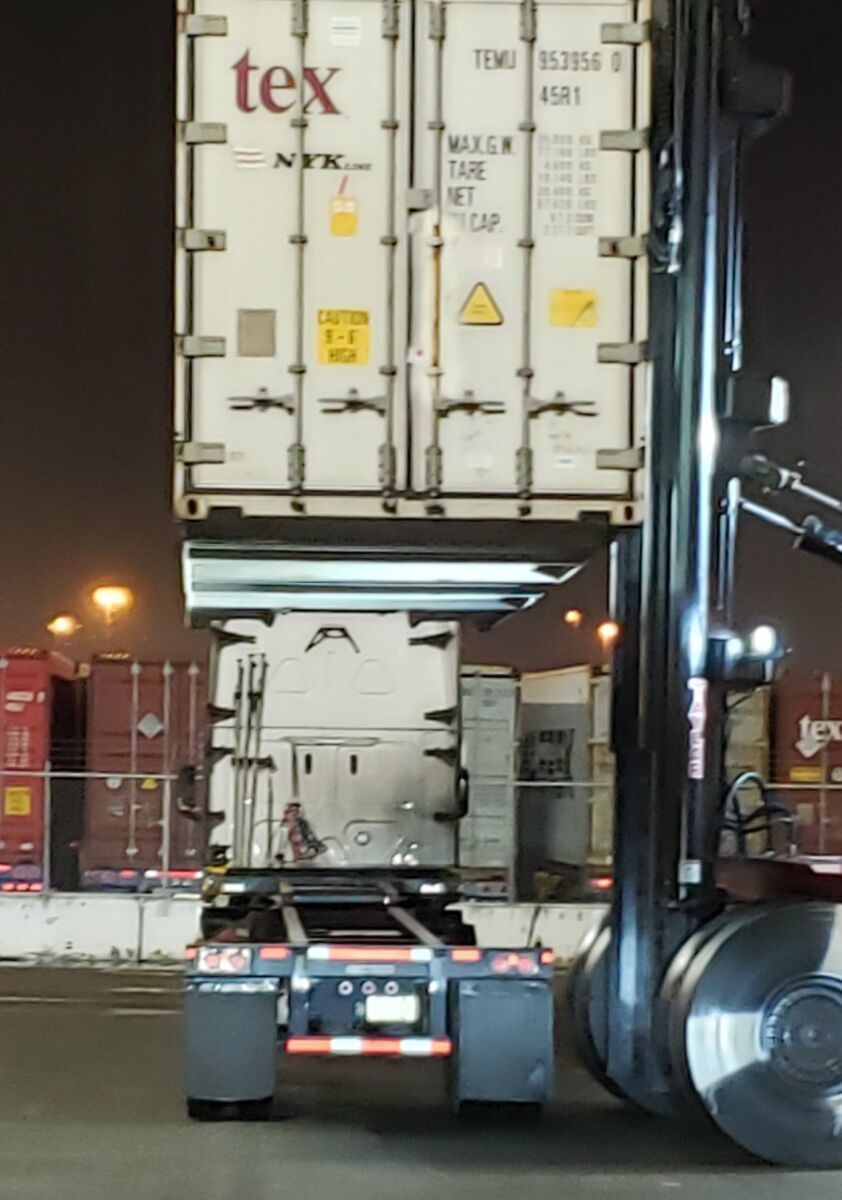
Below is another way the cans are stacked.
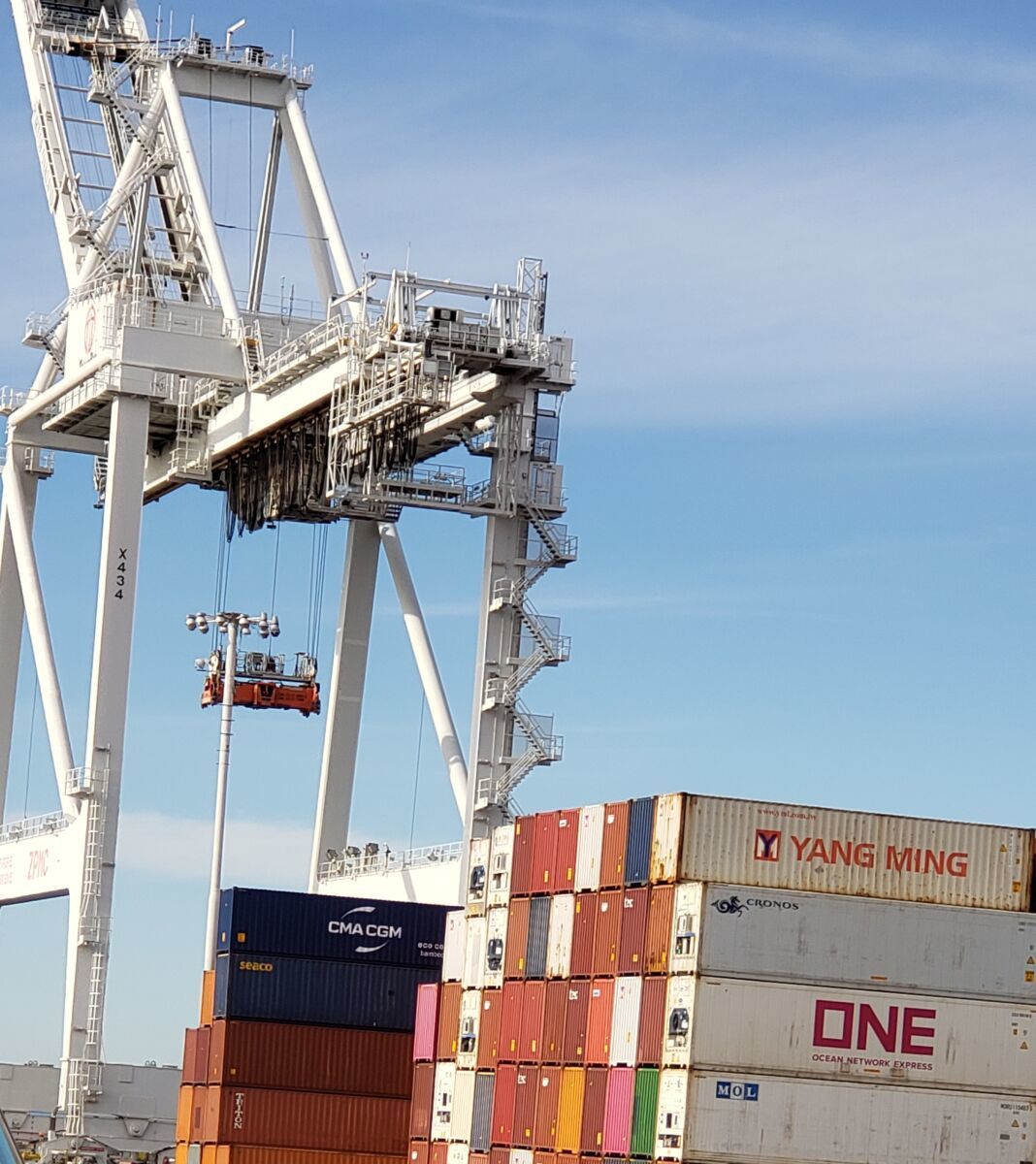
Not sure what the ship's tower is called.
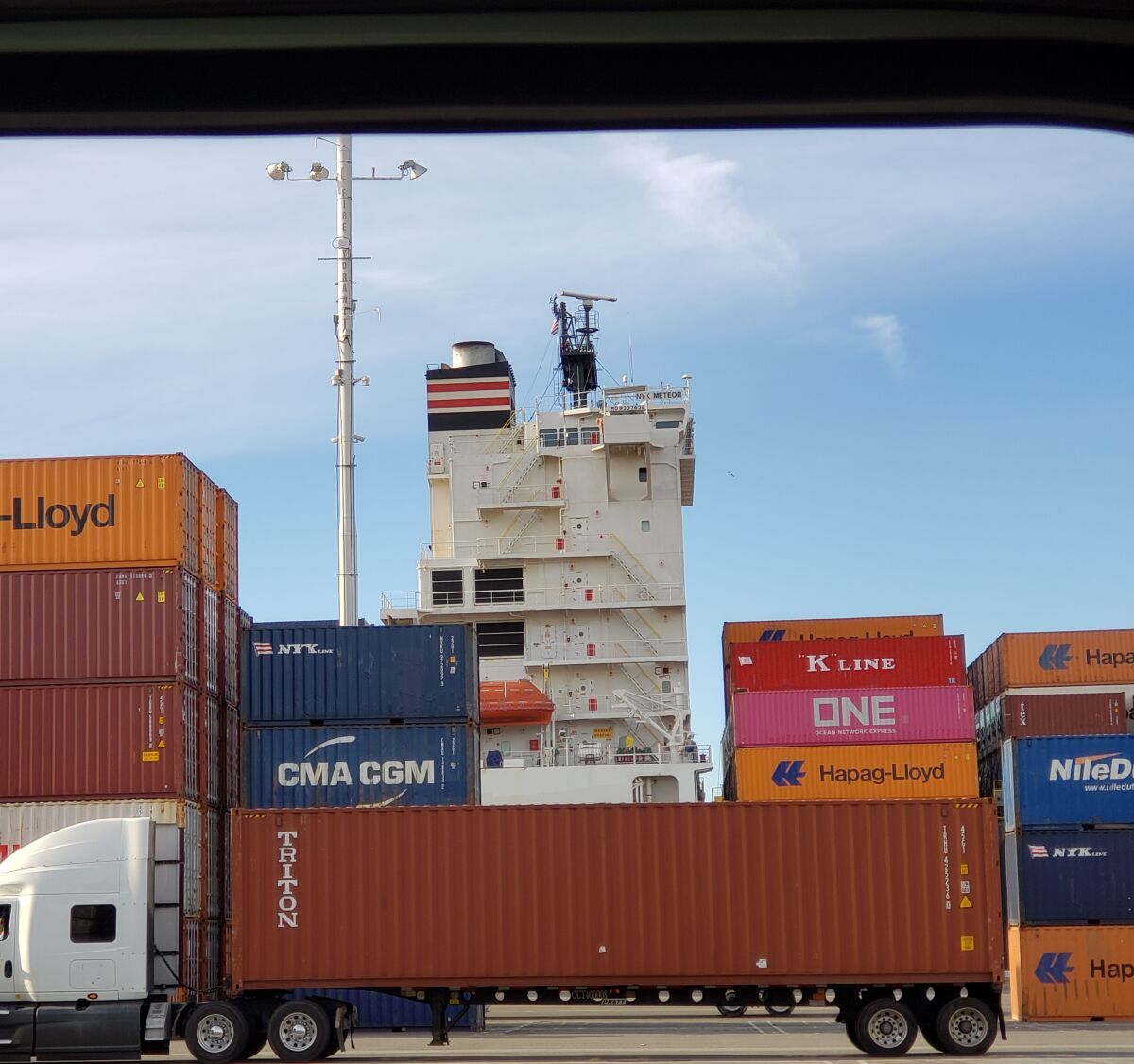
This is the racks that reefer cans are plugged in. The electrical banks are on each level and they are five high.
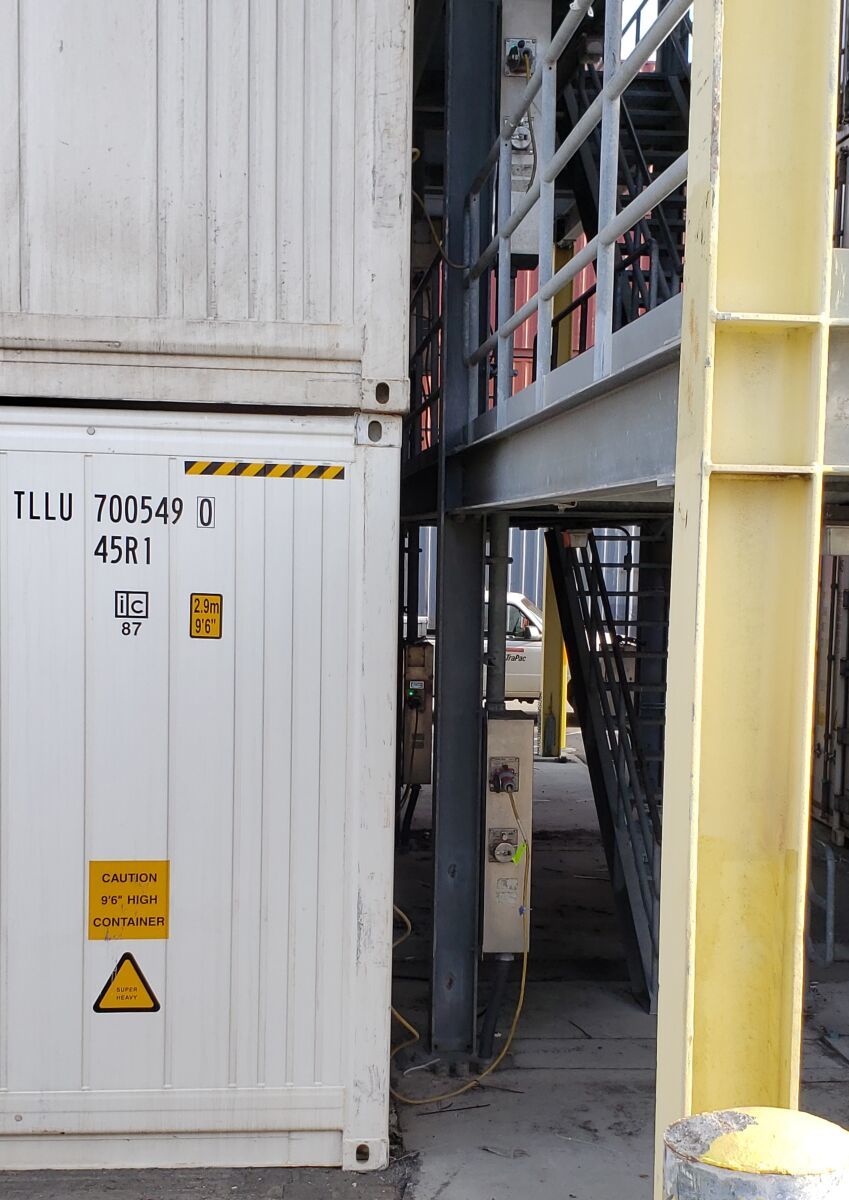
Laura
Reefer:
A refrigerated trailer.
Looks good. Heck, better than my first job. Trip planning is a breeze since it's the same 2 trips every time. You know what's for lunch and where you'll be stopping every trip. Here are the things you need to worry about....
Traffic delays are common in Mexico's Gay District (some of the old-timers still call it, "California"). You have some control about when you arrive so traffic delays should be minimal half the time BUT you have no say in how long you will be delayed at the port waiting. While it's only a 10 hour drive from SLC to Long Beach, you may spend that much time just being delayed at the port and by traffic on your trip back turning a 20 hour trip into a 30. You can extend your 14 hour clock up to three hours by putting yourself in the sleeper berth for the port delays. This might make you legal but it makes for a long (17 hours) day and only allows you a 7 hour break when you do shut down.
Holiday traffic will be extra difficult since traffic will generally be bumper to bumper from Las Vegas to Los Angeles. Ditto for any earthquakes.
Weather delays should be minimal, but you may see snow and ice near SLC. You know your local roads better than I do so I'll leave it at that.
Swift is good about maintenance so you don't have to worry about the truck. Trucks are usually retired at 500k miles and maintained properly. The trailers are a different story. A chassis is community property - not owned by Swift. Inspect your trailer very carefully. Issues with the brakes, lighting or tires will need to be dealt with, further delaying you. To secure the can to the chassis there are four levers, one on each corner of the chassis, you twist to lock the can to the chassis.
Knight/Swift is the largest trucking company in the US. Do a good job and there will be plenty of other opportunities available when you're ready to try something new. Dedicated? Yep. Linehaul? Yep. Flatbed? Tanker? Sure.
Sleeper Berth:
The portion of the tractor behind the seats which acts as the "living space" for the driver. It generally contains a bed (or bunk beds), cabinets, lights, temperature control knobs, and 12 volt plugs for power.
Linehaul:
Linehaul drivers will normally run loads from terminal to terminal for LTL (Less than Truckload) companies.
LTL (Less Than Truckload) carriers will have Linehaul drivers and P&D drivers. The P&D drivers will deliver loads locally from the terminal and pick up loads returning them to the terminal. Linehaul drivers will then run truckloads from terminal to terminal.New Reply:
New! Check out our help videos for a better understanding of our forum features

















Preview:






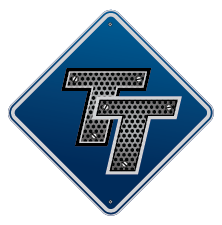

 TT On Facebook
TT On Facebook
Hey guys. Love the site and forums, I've been following closely for a while as I considered a career and then made the decision to begin attending a trucking school. I'm currently 3 weeks in to a 10 week program.
This morning a couple recruiters from Knight/Swift came in and gave the class a presentation. This job sounds really good. Dedicated run from Salt Lake City, (area where the school is located and where we the students live) down to the port of Long Beach and back twice a week. 5 days on and home for the weekend. According to them the guaranteed pay is $65 K / yr. No experience required.
From everything I've heard, it almost sounds too good to be true. Is this all smoke blowing up our asses? There's gotta be some catches. Anyone have experience working out of the port of Long Beach? Or any other ports? What's it like? Drawbacks?
Thanks for any feedback.
Dedicated Run:
A driver or carrier who transports cargo between regular, prescribed routes. Normally it means a driver will be dedicated to working for one particular customer like Walmart or Home Depot and they will only haul freight for that customer. You'll often hear drivers say something like, "I'm on the Walmart dedicated account."
TWIC:
Transportation Worker Identification Credential
Truck drivers who regularly pick up from or deliver to the shipping ports will often be required to carry a TWIC card.
Your TWIC is a tamper-resistant biometric card which acts as both your identification in secure areas, as well as an indicator of you having passed the necessary security clearance. TWIC cards are valid for five years. The issuance of TWIC cards is overseen by the Transportation Security Administration and the Department of Homeland Security.
OWI:
Operating While Intoxicated